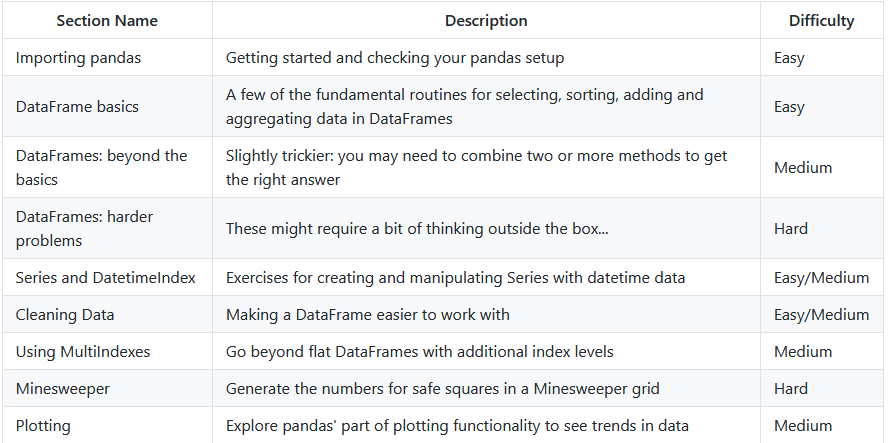数据分析-Pandas练习题
参考网站:
https://github.com/fengdu78/machine_learning_beginner/tree/master/pandas/Pandas_Exercises
https://github.com/ajcr/100-pandas-puzzles
https://blog.csdn.net/jclian91/article/details/84289537
1. Pandas_Exercises
1.Getting and knowing
- Chipotle
- Occupation
- World Food Facts
2.Filtering and Sorting
- Chipotle
- Euro12
- Fictional Army
3.Grouping
- Alcohol Consumption
- Occupation
- Regiment
4.Apply
- Students
- Alcohol Consumption
- US_Crime_Rates
5.Merge
- Auto_MPG
- Fictitious Names
- House Market
6.Stats
- US_Baby_Names
- Wind_Stats
7.Visualization
- Chipotle
- Titanic Disaster
- Scores
- Online Retail
- Tips
8.Creating Series and DataFrames
- Pokemon
9.Time Series
- Apple_Stock
- Getting_Financial_Data
- Investor_Flow_of_Funds_US
10.Deleting
- Iris
- Wine
2. Pandas 100

#!/usr/bin/env python # coding: utf-8 # In[1]: import pandas as pd # In[2]: pd.__version__ # In[3]: pd.show_versions() # In[5]: import numpy as np data = {'animal': ['cat', 'cat', 'snake', 'dog', 'dog', 'cat', 'snake', 'cat', 'dog', 'dog'], 'age': [2.5, 3, 0.5, np.nan, 5, 2, 4.5, np.nan, 7, 3], 'visits': [1, 3, 2, 3, 2, 3, 1, 1, 2, 1], 'priority': ['yes', 'yes', 'no', 'yes', 'no', 'no', 'no', 'yes', 'no', 'no']} labels = ['a', 'b', 'c', 'd', 'e', 'f', 'g', 'h', 'i', 'j'] # In[52]: df = pd.DataFrame(data, index=labels,dtype=float) # In[53]: df.info() # In[8]: df.describe() #对整型数据或浮点数进行求均值、四分位数 # In[12]: #Return the first 3 rows of the DataFrame df. df.iloc[:3] #返回三行数据,其余行的数据不返回 # In[13]: df.head(5) #DataFrame由行和列组成,label为行标签 # In[14]: df.loc[:, ['animal', 'age']] # In[20]: df.loc[:,['animal', 'priority']] #返回animal, priority列的所有数据 # In[21]: #Select the data in rows [3, 4, 8] and in columns ['animal', 'age']. df.loc[df.index[[3, 4, 8]], ['animal', 'age']] #可见loc有时可以起到与iloc同样的作用 # In[23]: #Select only the rows where the number of visits is greater than 3. df[df['visits'] > 3] # In[24]: df[df['age'].isnull()] # In[25]: df[(df['animal'] == 'cat') & (df['age'] < 3)] # In[26]: df[df['age'].between(2, 4)] # In[27]: df.loc['f', 'age'] = 1.5 #区分loc, iloc,loc[a, b],a为行属性,b为列属性 # In[28]: df # In[29]: df['visits'].sum() # In[30]: df.groupby('animal')['age'].mean() #以animal分类,求age均值 # In[31]: df.loc['k'] = [5.5, 'dog', 'no', 2] #loc增加k行 # In[32]: df # In[33]: df = df.drop('k') #删除k行 # In[34]: df['animal'].value_counts() #以animal分类,暂不明白,value_counts对何计数 # In[35]: df.sort_values(by=['age', 'visits'], ascending=[False, True]) #按age降序,False降序,True升序,两者冲突时以前者为准 # In[38]: df.sort_values(by = ['visits'],ascending = [False]) # In[39]: #The 'priority' column contains the values 'yes' and 'no'. Replace this column with a column of boolean values: 'yes' should be True and 'no' should be False. df['priority'] = df['priority'].map({'yes': True, 'no': False}) #map可以快速匹配字典的key,返回value # In[40]: df # In[41]: df['animal'] = df['animal'].replace('snake', 'python') # In[42]: df # In[58]: df.loc['d', 'age'] = 1 df.loc['h', 'age'] =5 # In[59]: df # In[62]: df # In[63]: #For each animal type and each number of visits, find the mean age. In other words, each row is an animal, each column is a number of visits and the values are the mean ages (hint: use a pivot table). df.pivot_table(index= ['animal'], columns= ['visits'], values=['age'], aggfunc=['mean']) #暂时有问题,因age存在NaN,故先填充数据,此外发现还需要先制定数据类型 # In[67]: df = pd.DataFrame({'A': [1, 2, 2, 3, 4, 5, 5, 5, 6, 7, 7]}) # In[68]: df # In[69]: #How do you filter out rows which contain the same integer as the row immediately above? df.loc[df['A'].shift() != df['A']] # In[72]: df = pd.DataFrame(np.random.random(size=(5, 3))) # In[73]: df # In[83]: df.sub(df.mean(axis=1), axis =0) #axis=1 对每行数据处理,输出每行,axis=0,对每列数据处理 # In[78]: df.mean(axis = 1) # In[84]: df = pd.DataFrame(np.random.random(size=(5, 10)), columns=list('abcdefghij')) # In[85]: df # In[86]: df.sum().idxmin() # In[87]: #How do you count how many unique rows a DataFrame has (i.e. ignore all rows that are duplicates) len(df.drop_duplicates(keep=False)) # In[108]: df = pd.DataFrame(np.random.random(size=(6,10)), columns =list('abcdefghij') ) # In[109]: df # In[112]: df.loc[4, 'g'] = np.nan df.loc[1, 'd'] = np.nan df.loc[5, 'f'] = np.nan # In[113]: df # In[114]: (df.isnull().cumsum(axis=1) == 3).idxmax(axis=1) # In[115]: df = pd.DataFrame({'grps': list('aaabbcaabcccbbc'), 'vals': [12,345,3,1,45,14,4,52,54,23,235,21,57,3,87]}) # In[116]: df # In[117]: df.groupby('grps')['vals'].nlargest(3).sum(level=0) # In[143]: df = pd.DataFrame({'A': range(1,101), 'B': np.random.randint(1,100)}) # In[144]: df # df.groupby(pd.cut(df['A'], np.arange(0, 101, 10)))['B'].sum() # In[146]: df = pd.DataFrame({'X': [7, 2, 0, 3, 4, 2, 5, 0, 3, 4]}) # In[147]: df # In[149]: x = (df['X'] != 0).cumsum() y = x != x.shift() df['Y'] = y.groupby((y != y.shift()).cumsum()).cumsum() # df 截止到第29题
3. Pandas Tutorial
4. 函数用法积累
4.1 pd.Categorical
返回字符所属类别的位置索引

